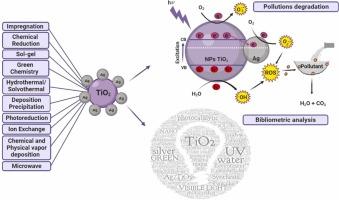Photocatalytic action of Ag/TiO2 nanoparticles to emerging pollutants degradation: A comprehensive review
引用次数: 0
Abstract
Silver (Ag) doped titanium dioxide (TiO2) nanoparticles are promising photocatalysts for the degradation of emerging pollutants. These nanocomposites enhance the photocatalytic activity of TiO2 in visible light, suppress the e-/h+ rearrangement, and enhance their bactericidal properties. This review proposes a bibliometric analysis that elucidates research trends, and important topics on contaminant degradation, analyzes the advantages and limitations of different synthesis techniques (solvothermal, photochemical reduction, sol-gel, and others), their properties to produce Ag/TiO2, and their potential for pollutant degradation. Thus, depending on the technique chosen, Ag doping of TiO2 can offer high stability, recyclability for more than 3 cycles, customized morphologies and sizes, among others. Applications of Ag/TiO2 include wastewater treatment, antibacterial surfaces, food packaging, implants, and others. Advances in the synthesis of Ag/TiO2 photocatalysts offer excellent photocatalytic degradation, between 80 % and 100 %, for organic dyes, hormones, pharmaceuticals, pesticides and other emerging pollutants. Ag/TiO2 photocatalysts show superior degradation rates compared to pure TiO2, with some achieving up to 99 % pollutant removal. The bibliometric analysis performed by Methodi Ordinatio, classifying 267 articles, reveals a foundation of relevant articles, around 35 % of articles published on these topics were published between 2019 and 2021. A complete cost analysis of Ag/TiO2 is considered to determine the feasibility for pilot and large-scale experimentation. These nanocomposites offer a promising solution to address the growing concern about emerging pollutants, disinfection of water, and in the inactivation of pathogenic microorganisms.

Ag/TiO2纳米粒子对新出现污染物降解的光催化作用:综述
掺银(Ag)的二氧化钛(TiO2)纳米粒子是一种很有前途的光催化剂,可用于降解新出现的污染物。这些纳米复合材料提高了二氧化钛在可见光下的光催化活性,抑制了 e-/h+ 重排,并增强了其杀菌性能。本综述通过文献计量分析,阐明了污染物降解方面的研究趋势和重要课题,分析了不同合成技术(溶热法、光化学还原法、溶胶-凝胶法等)的优势和局限性、它们生产 Ag/TiO2 的特性及其降解污染物的潜力。因此,根据所选技术的不同,在二氧化钛中掺杂银可以提供高稳定性、超过 3 个循环的可回收性、定制的形态和尺寸等。Ag/TiO2的应用领域包括废水处理、抗菌表面、食品包装、植入物等。Ag/TiO2 光催化剂合成技术的进步为有机染料、激素、药品、杀虫剂和其他新兴污染物提供了出色的光催化降解能力,降解率在 80% 到 100% 之间。与纯二氧化钛相比,Ag/TiO2 光催化剂的降解率更高,其中一些对污染物的去除率高达 99%。Methodi Ordinatio 对 267 篇文章进行了文献计量分析,发现了相关文章的基础,其中约 35% 的文章发表于 2019 年至 2021 年期间。对 Ag/TiO2 进行了全面的成本分析,以确定试点和大规模实验的可行性。这些纳米复合材料为解决人们日益关注的新兴污染物、水消毒和病原微生物灭活问题提供了一种前景广阔的解决方案。
本文章由计算机程序翻译,如有差异,请以英文原文为准。
求助全文
约1分钟内获得全文
求助全文

 求助内容:
求助内容: 应助结果提醒方式:
应助结果提醒方式:


